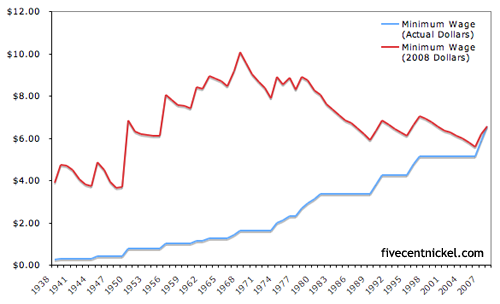 unemployment?
unemployment?The argument is rather straightforward. If there is a minimum wage then any worker who produces less value than the minimum wage will be fired as they cost more than they are worth, this will inevitably lead to unemployment (I have simplified it slightly). The argument holds and is the basis of almost all opposition to minimum wages. Indeed one has to ask why anyone supports the minimum wage if it leads to unemployment, well the answer is it doesn't, not necessarily.
Hang on a sec! You just said it did! Well, let's go back to our previous argument and ask what if people are not being paid an amount equal to the extra value they add (marginal revenue product/MRP)? Under a perfectly competitive system this wouldn't be the case, markets would clear until the wage equal the MRP of the worker. However, do we have a perfectly competitive market? The answer is no, well kinda.
Under perfect conditions, there is no cost to the worker in changing job and any cut in wage means they will simply move company. It also assumes that workers are indifferent between jobs (clearly not the case). These conditions (among others) result in a measure of market power moving towards the employer. As a result we see less people employed than in a competitive system and these people are employed at a lower wage than would prevail under competitive conditions. The graph from wiki illustrates this well (but it is somewhat complicated).
-The axes L and w refer to the quantity of labour employed and the wage paid (respectively).
-The red line is the marginal revenue product of an extra worker. (i.e. the extra value an additional worker would add to the firm).
- The blue line is the supply of labour. (i.e. the amount of labour forthcoming at each wage level).
-The green line is the marginal cost of labour (how much it costs the firm to hire an additional person).
Now under a perfectly competitive system we expect the firm to produce at level C with wages w' and L' labour employed. At this point the wage of the employee is equal to the MRP (as mentioned above). If however the employer enjoys some monopsonistic (or oligopsonistic) power then this is not the case. Instead the firm does not have to worry about workers being siphoned away by competition and so does not have to raise wages to keep employees. In this case the firm maximises its profits by employing more labour until MC (the extra cost of a worker) is equal to MRP (the extra value of a worker). This occurs at point A and leads to a wage w and employment L. Both w and L are below the equilibrium in the competitive system. i.e. less people and lower wages.
Now, back to the minimum wage. Under these conditions a minimum wage set between w and w' above not only leads to an increase in wages but also an increase in employment! This is an amazing result and can actually be used to test the prevelance of monopsony in a market. Now, if there does exist monopsony (due to a lack of knowledge, job-search frictions etc.) then there certainly is a case for the minimum wage. As to what it should be set at? That is a difficult question and must rely on emprical observation. The main thing is however, that the minimum does not always lead to unemployment and may in fact increase both employment and wages. For anyone interested in this, I strongly recommend this paper. It is reader-friendly and explains the whole situation far better than I can.

No comments:
Post a Comment